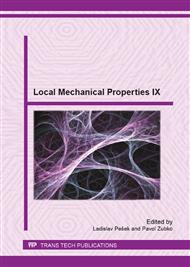[1]
Y. Pauleau, Ph. Gouy-Pailler, Very hard solid-solution-type tungsten-carbon coatings deposited by reactive magnetron sputtering, Mater. Lett. 13 (1992) 157-160.
DOI: 10.1016/0167-577x(92)90129-8
Google Scholar
[2]
N. Radic, B. Gržeta, O. Milat, J. Ivkov, M. Stubičar, Tungsten-carbon films prepared by reactive sputtering from argon-benzene discharges, Thin Solid Films 320 (1998) 192-197.
DOI: 10.1016/s0040-6090(97)00758-x
Google Scholar
[3]
C. Rebholz, J.M. Schneider, A. Leyland, A. Matthews, Wear behavior of carbon-containing tungsten coating prepared by reactive magnetron sputtering, Surf. Coat. Technol. 112 (1999) 85-90.
DOI: 10.1016/s0257-8972(98)00786-5
Google Scholar
[4]
S. Yang, D. Camino, A.H.S. Jones, D.G. Teer, Deposition and tribological behavior of sputtered carbon hard coatings, Surf. Coat. Technol. 124 (2000) 110-116.
DOI: 10.1016/s0257-8972(99)00634-9
Google Scholar
[5]
A. Czyzniewski, Deposition and some properties of nanocrystalline WC and nanocomposite WC/a-C: H coatings, Thin Solid Films 433 (2003) 180-185.
DOI: 10.1016/s0040-6090(03)00324-9
Google Scholar
[6]
M.D. Abad, M.A. Munoz-Márquez, S. El Mrabet, A. Justo, J.C. Sánchez-López, Tailored synthesis of nanostructured WC/a-C coatings by dual magnetron sputtering, Surf. Coat. Technol. 204 (2010) 3490-3500.
DOI: 10.1016/j.surfcoat.2010.04.019
Google Scholar
[7]
Y. Liu, M. Gubisch, W. Hild, M. Scherge, L. Spiess, C. Knedlik, J.A. Schaefer, Nanoscale multilayer WC/C coatings developed for nanopositioning, part II: Friction and wear, Thin Solid Films 488 (2005) 140-148.
DOI: 10.1016/j.tsf.2005.03.020
Google Scholar
[8]
Y. Liu, M. Gubisch, L. Spiess, J.A. Schaefer, Sliding friction of nanocomposite WC1-x/C coatings: transfer film and its influence on tribology, J. Nanosci Nanotechnol. 9 (2009) 3499-3505.
DOI: 10.1166/jnn.2009.ns23
Google Scholar
[9]
S. El Mrabet, M.D. Abad, J.C. Sánchez-López, Identification of the wear mechanisms on WC/C nanostructured coatings, Surf. Coat. Technol. 206 (2011) 1913-20.
DOI: 10.1016/j.surfcoat.2011.07.059
Google Scholar
[10]
F. Lofaj, M. Mikula, B. Grančič, G. Cempura, P. Horňák, P. Kúš, D. Kottfer, Tribological properties of TiBx and WC/C coatings, Ceramics – Silikáty 55 (2011) 305-11.
Google Scholar
[11]
F. Lofaj, M. Ferdinandy, G. Cempura, J. Dusza, Nanoindentation, AFM and tribological properties of thin nc-WC/a-C coatings, J. Eur. Ceram. Soc. 32 (2012) 2043-51.
DOI: 10.1016/j.jeurceramsoc.2012.01.037
Google Scholar
[13]
F. Lofaj, M. Ferdinandy, G. Cempura, P. Horňák, M. Vnouček, Transfer film in a friction contact in the nanocompositeWC-C coatings, J. Australian Ceram. Soc. 49 (2013) 37-46.
Google Scholar
[14]
S. El Mrabet, M.D. Abad, C. López-Cartes, D. Martínez-Martínez, J.C. Sánchez-López, Thermal evolution of WC/C nanostructured coatings by Raman and in situ XRD analysis, Plasma Process. Polym. 6 (2009) 444-49.
DOI: 10.1002/ppap.200931004
Google Scholar


